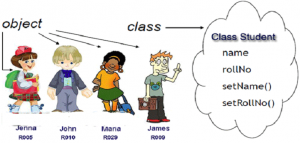
Following are some of the key points described later in this article:
- Why write a PHP class?
- Key aspects of a PHP class
- A PHP class – Code Example
- Using PHP class in PHP files
Why Write a PHP Class?
As a beginner, I have come across this common thing that PHP developers tend to write one or more functions in the PHP files/scripts. As a matter of fact, I have also come across several projects (profitable ones) which were written with a few PHP files, very large ones, having all the code put in them in form of multiple functions. When learning PHP, it is OK to do in this way. However, for web apps to go to production, this may not be the recommended way. Following are some of the disadvantages of writing PHP scripts with just the functions in it:
- Low Maintainability: These files with functions are difficult to maintain/manage (change). Thinking of writing unit tests is like next to impossible. In addition to low testability, there may be several functions which could be reused. However, due to the way they get written, the files score low on re-usability as well. It also propagates the code duplication which further impacts code maintainability as changing a functionality would require change at several places.
- Low Usability: These files are difficult to read and understand.
To take care of some of the above issues, one should learn writing PHP using object-oriented manner, e.g., writing code in form of one or more classes. Writing PHP code using classes helps one should segregate similar looking functions in a class (Single Responsibility Principle) and use the class elsewhere in the code (different PHP scripts). As a matter of fact, one could easily follow SOLID principle with PHP and make the code well-structured. Doing this way does propagate high maintainability (high testability, high cohesiveness, high reusability etc) and makes code readable and understandable.
Key Aspects of a PHP Class
Following are some of the key aspects of a PHP class:
- Define a class with keyword “class” followed by name of the class
- Define the constructor method using “__construct” followed by arguments. The object of the class can then be instantiated using “new ClassName( arguments_list )”
- Define class variables. One could access specifiers such as private, public, protected etc.
- Define methods using “function” keyword. By default, PHP methods, if not specified with any access specifier becomes public in nature.
That is it!
A PHP Class – Code Example
Following is the code example of a PHP class, User. Pay attention to some of the following:
- “class” followed by “User”, the class name
- Member variables such as $name, $age
- Member functions such as getName, isAdult
class User {
private $name;
private $age;
function __construct( $name, $age ) {
$this->name = $name;
$this->age = $age;
}
function getName() {
return $this->name;
}
function isAdult() {
return $this->age >= 18?"an Adult":"Not an Adult";
}
}
Save the file as User.php. Don’t forget to put the above code within <?php and ?>
Using PHP Class in PHP files
Finally, its time to use the PHP class. If you are working with a sample project, go to index.php. Assuming that User.php is saved in same folder as index.php, following is how the code would look like. Pay attention to some of the following:
- “require” keyword used to include User class written inside User.php
- “new” keyword used to instantiate the User class
- -> used to invoke methods on the object
<?php
require "User.php";
$h = new User( "Calvin", 15 );
echo "Hello, " . $h->getName(). "! You are ". $h->isAdult();
?>
<br/>
<?php
$h = new User( "Chris", 39 );
echo "Hello, " . $h->getName(). "! You are ". $h->isAdult();
?>
- Book: First principles thinking for building winning products - April 19, 2022
- Free AI / Machine Learning Courses at Alison.com - November 16, 2021
- 12 Weeks Free course on AI: Knowledge Representation & Reasoning (IIT Madras) - November 14, 2021
http://eev.ee/blog/2012/04/09/php-a-fractal-of-bad-design/